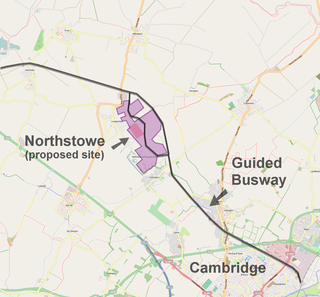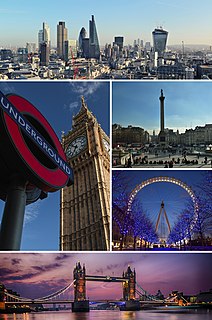
International development or global development is a broad concept denoting the idea that societies and countries have differing levels of 'development' on an international scale. It is the basis for international classifications such as developed country, developing country and least developed country, and for a field of practice and research that in various ways engages with international development processes. There are, however, many schools of thought and conventions regarding which are the exact features constituting the 'development' of a country.

Beddington Zero Energy Development (BedZED) is an environmentally friendly housing development in Hackbridge, London, England. It is in the London Borough of Sutton, 2 miles (3 km) north-east of the town of Sutton itself. Designed to create zero carbon emissions, it was the first large scale community to do so.

Green building refers to both a structure and the application of processes that are environmentally responsible and resource-efficient throughout a building's life-cycle: from planning to design, construction, operation, maintenance, renovation, and demolition. This requires close cooperation of the contractor, the architects, the engineers, and the client at all project stages. The Green Building practice expands and complements the classical building design concerns of economy, utility, durability, and comfort.
Sustainable urban infrastructure expands on the concept of urban infrastructure by adding the sustainability element with the expectation of improved and more sustained urban development. In the construction and physical and organizational structures that enable cities to function, there is the aim of meeting the needs of the present generation without compromising the capabilities of the future generations.

The Craik Sustainable Living Project (CSLP) is a nonprofit organization for sustainable development that aims to advance the local use of more ecologically sound technologies and ways of living in rural Saskatchewan, Canada. The four key components of the project are the eco-centre, outreach and education programs, community action, and the ecovillage.

A zero-energy building, also known as a zero net energy (ZNE) building, net-zero energy building (NZEB), net zero building or zero-carbon building is a building with zero net energy consumption, meaning the total amount of energy used by the building on an annual basis is roughly equal to the amount of renewable energy created on the site, or in other definitions by renewable energy sources elsewhere. These buildings consequently contribute less overall greenhouse gas to the atmosphere than similar non-ZNE buildings. They do at times consume non-renewable energy and produce greenhouse gases, but at other times reduce energy consumption and greenhouse gas production elsewhere by the same amount. A similar concept approved and implemented by the European Union and other agreeing countries is nearly Zero Energy Building (nZEB), with the goal of having all buildings in the region under nZEB standards by 2020.
Sustainable cities, urban sustainability, or eco-city is a city designed with consideration for social, economic, environmental impact [1][1], and resilient habitat for existing populations, without compromising the ability of future generations to experience the same. These cities are inhabited by people whom are dedicated towards minimization of required inputs of energy, water, food, waste, output of heat, air pollution - CO
2, methane, and water pollution. Richard Register first coined the term "ecocity" in his 1987 book, Eco city Berkeley: Building Cities for a Healthy Future. Other leading figures who envisioned the sustainable city are architect Paul F Downton, who later founded the company Ecopolis Pty Ltd, as well as authors Timothy Beatley and Steffen Lehmann, who have written extensively on the subject. The field of industrial ecology is sometimes used in planning these cities.
The Aga Khan Planning and Building Service (AKPBS) was established in 1980 as an agency of the Aga Khan Development Network (AKDN). The agency works to improve the built environment, particularly housing design and construction, village planning, natural hazard mitigation, environmental sanitation, water supplies, and other living conditions. It does this by providing material, technical assistance and applied research, as well as planning and construction management services for communities in both rural and urban areas.
The Office of Energy Efficiency and Renewable Energy (EERE) is an office within the United States Department of Energy. Formed from other energy agencies after the 1973 energy crisis, EERE's mission is to help support the development of clean, renewable and efficiency energy technologies to America and support a global clean energy economy. The Office of EERE is led by the Assistant Secretary of Energy Efficiency and Renewable Energy, who oversees three technology sectors: renewable energy, sustainable transportation, and energy efficiency. Within these sectors are 11 major technology offices and programs that support research, development, and outreach efforts.

Northstowe is a new town that will eventually have up to 10,000 homes in Cambridgeshire, UK. The new town will fall in the Longstanton ward of South Cambridgeshire District Council. Northstowe has been in development for around 15 years and through varying political administrations. Originally proposed to be "an exemplar of sustainability in the use of renewable energy resources and reducing carbon emissions", Northstowe will still have many exemplar features. The Northstowe site is located five miles northwest of the city of Cambridge, between the villages of Oakington and Longstanton. The Northstowe development is being led by the Homes and Communities Agency and the developers Gallagher Estates.
This page is an index of sustainability articles.
This article provides examples of Green Building programs in the United States. These programs span the public, private, and non-profit sectors, and all have the goal of increasing energy efficiency and the sustainability of the built environment.
The California Sustainability Alliance is an organization funded by the California IOUs to bring together key stakeholders needed to overcome the obstacles of sustainability. The Alliance was designed in 2008 to help meet the State’s aggressive climate, energy and other resource and environmental goals by increasing and accelerating sustainable measures and strategies. The Alliance specifically focuses on energy efficiency, climate action, “smart growth” principles, renewable energy development, water-use efficiency, waste management, and transportation management within California.
Environmentally sustainable design is the philosophy of designing physical objects, the built environment, and services to comply with the principles of ecological sustainability.
Building for Life is a tool for assessing the design quality of homes and neighbourhoods in England. It was developed by the Commission for Architecture and the Built Environment (CABE), with partners the Home Builders Federation, the Civic Trust and Design for Homes.
Sustainability organizations are (1) organized groups of people that aim to advance sustainability and/or (2) those actions of organizing something sustainably. Unlike many business organizations, sustainability organizations are not limited to implementing sustainability strategies which provide them with economic and cultural benefits attained through environmental responsibility. For sustainability organizations, sustainability can also be an end in itself without further justifications.
Sustainable urbanism is both the study of cities and the practices to build them urbanism that focus on promoting their long term viability by reducing consumption, waste and harmful impacts on people and place while enhancing the overall well being of both people and place. Well being includes the physical, ecological, economic, social, health and equity factors, among others, that comprise cities and their populations. In the context of contemporary urbanism, the term cities refers to several scales of human settlements from towns to cities, metropolises and mega-city regions that includes their peripheries / suburbs / exurbs. Sustainability is a key component to professional practice in urban planning and urban design along with its related disciplines landscape architecture, architecture, and civil and environmental engineering. Green urbanism and ecological urbanism are other common terms that are similar to sustainable urbanism, however they can be construed as focusing more on the natural environment and ecosystems and less on economic and social aspects. Also related to sustainable urbanism are the practices of land development called Sustainable development, which is the process of physically constructing sustainable buildings, as well as the practices of urban planning called smart growth or growth management, which denote the processes of planning, designing, and building urban settlements that are more sustainable than if they were not planned according to sustainability criteria and principles.

The INTEGER Millennium House is a demonstration house in Watford, England that opened to the public in 1998. It was renamed The Smart Home after being refurbished in 2013. The house was originally intended to showcase innovations in design and construction, building intelligence, and environmental performance. The INTEGER design included many innovative features, including environmental technology such as a green roof and a grey water recycling system, home automation that included a building management system and an intelligent security system, and innovative technical systems such as under-floor trench heating. In 2013, the house was refurbished and retrofitted with a variety of new and upgraded features, including a building-integrated photovoltaic (BIPV) array, which altogether halved its carbon emissions and increased its energy efficiency by 50%. Since its creation, the house has garnered numerous awards, appeared on Tomorrow's World on BBC Television, hosted thousands of visitors, and influenced mainstream construction.

The Nigerian Capital Development Fund is an independent social investment financial intermediary institution. This hybrid organization was set up mainly to address the challenges of poverty in low income rural communities in Nigeria. The institution mobilizes capital from the public and private sectors to invest in projects, businesses and social enterprises with the intention to generate good financial returns and measurable positive social-environmental impact, as well as act as a champion to help increase awareness and confidence on the advantages of impact investing.













